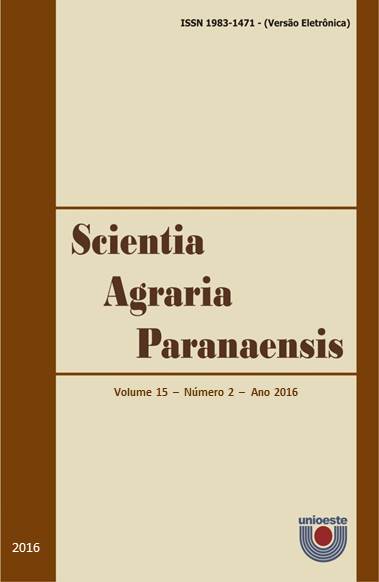Produção de espécies forrageiras produtoras de grãos e composição química de silagens
DOI:
https://doi.org/10.18188/sap.v15i2.12968Palavras-chave:
Helianthus annuus, Pennisetum glaucum, Sorghum bicolor, Zea maysResumo
Objetivou-se avaliar características de produção de espécies forrageiras produtoras de grãos e composição química de silagens nas condições do nordeste do Brasil. Foram avaliadas quatro forrageiras produtoras de grãos: milho, milheto, sorgo e girassol. Foram determinadas a massa seca de forragem morta (MSFM), massa seca total de grão (MSTG), massa seca total de folha (MSTF) e massa seca total de colmo (MSTC). Da silagem produzida com as espécies, avaliou-se o nitrogênio amoniacal, perdas por gases (G), perdas por efluentes (E), rendimento de matéria seca (RMS), matéria seca (MS), proteína bruta (PB), extrato etéreo (EE), matéria mineral (MM), fibra detergente neutro (FDN) e fibra detergente ácido (FDA). O sorgo apresentou maior (p<0,05) acúmulo de MSFM, MSTF e MSTC em relação ao milho, milheto e girassol. O girassol apresentou maiores perdas por G e E, e menor RMS para silagem produzida. Não houve diferença das silagens em relação a PB. Para o EE a silagem de girassol obteve maior quantidade, fato que compromete a qualidade da silagem para alimentação de ruminantes. O sorgo possui caracterização mais adequada para produção de silagem, pois apresenta alta produção de volumoso, baixas perdas e composição química semelhante à silagem do milho nas condições do nordeste do Brasil.
Downloads
Publicado
Como Citar
Edição
Seção
Licença
Aviso de Direito Autoral Creative Commons
Política para Periódicos de Acesso Livre
Autores que publicam nesta revista concordam com os seguintes termos:
1. Autores mantém os direitos autorais e concedem à revista o direito de primeira publicação, com o trabalho simultaneamente licenciado sob a Licença Creative Commons Attribution que permite o compartilhamento do trabalho com reconhecimento da autoria e publicação inicial nesta revista.2. Autores têm autorização para assumir contratos adicionais separadamente, para distribuição não-exclusiva da versão do trabalho publicada nesta revista (ex.: publicar em repositório institucional ou como capítulo de livro), com reconhecimento de autoria e publicação inicial nesta revista.
3. Autores têm permissão e são estimulados a publicar e distribuir seu trabalho online (ex.: em repositórios institucionais ou na sua página pessoal) a qualquer ponto antes ou durante o processo editorial, já que isso pode gerar alterações produtivas, bem como aumentar o impacto e a citação do trabalho publicado (Veja O Efeito do Acesso Livre).
Licença Creative Commons
Esta obra está licenciada com uma Licença Creative Commons Atribuição-NãoComercial-CompartilhaIgual 4.0 Internacional, o que permite compartilhar, copiar, distribuir, exibir, reproduzir, a totalidade ou partes desde que não tenha objetivo comercial e sejam citados os autores e a fonte.


